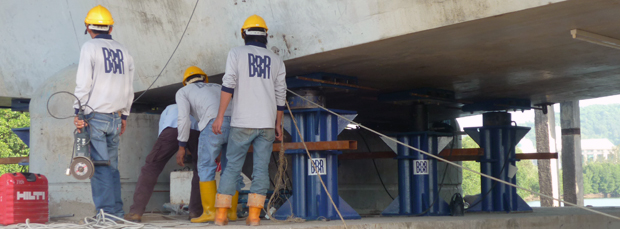MRR techniques
The BBR Network offers a wide range of specialist Maintenance, Retrofit and Restoration or Renovation MRR techniques and technology which deliver leading edge green and economic solutions in our cost-conscious and environmentally aware world. Such MRR techniques include fiber reinforced polymer FRP application, bearing replacement, external post-tensioning and Impressed Current Cathodic Protection ICCP.
In addition to the above techniques, other specialist procedures, such as heavy lifting are provided. The BBR Network Members are able to provide all the necessary engineering support, have the knowledge, skills and resources as well as equipment and material to challenge nearly all project needs.
Fiber reinforced polymer FRP
FRP has the advantage of being lightweight, yet strong. Additional shear capacity, flexural strength and ductility can be applied to beams, columns, slabs and walls by the application of fiber reinforced polymer materials – with minimal disturbance to occupancy and rentable asset space. It is applied as a ‘wrap’ or in strips to strengthen weak or damaged concrete.
Benefits of FRP:
- Low unit weight (between 150 and 900 mg/m2)
- Low profile thickness
- Ease of handling and application due to light weight
- High E-modulus – carbon modulus is greater than that of steel
- Excellent fatigue behavior
- Corrosion resistant
- Can be covered with a variety of coatings
Bearing replacement
 |
Typically, bearings are found in bridges and form a cushion between the bridgepiers and the bridge deck. Replacing bridge bearings, when they have reached the end of their design life, requires the development of precise procedures and the application of heavy lifting techniques – jacking – to raise the bridge deck to allow removal and insertion of bearings.
External PT strengthening
 |
The use of externally placed post-tensioning tendons to increase load carrying capacity is a well-established practice. In principle, induced tensile stresses in concrete due to additional loading can be negated by applying compressive stresses induced by post-tensioning. The technique is used mainly in bridges, where additional load carrying capacity is often required. For example, BBR VT CONA CMB external band tendons can be applied to ensure continued service of the bridges for a further period. External post-tensioning can be applied to buildings to increase structural strength. External tendons strengthen and increase the load capacity of a structure and their effect comes into play immediately after they are stressed, hence the technology often being called ‘active’ strengthening. CONA CME external tendons are the right solution for such applications.
Impressed Current Cathodic Protection
Impressed Current Cathodic Protection (ICCP) systems are installed to inhibit the corrosion of steel reinforcing bars in concrete structures – particularly if the latter are in aggressive marine environments. The systems operate by passing a low voltage current through strategically placed anodes inserted into the concrete which forces the reinforcing steel into a cathodic state and protects it from corrosion. The ICCP control system monitors and records performance.
The expertise of the BBR Network in the area of maintenance, repair and retrofit or renovation is founded on a long experience and understanding of structures, as well as the professional, effective and safe application of the latest technologies.
CONA CME approvals
European Technical Approvals in different languages
See our Downloads page
CONA CMB approvals
European Technical and additional approvals in different languages
See our Downloads page





